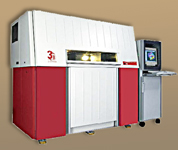|
 SLS stands for “Selective Laser Sintering”. This method
was developed and patented by Dr. Carl Deckard at the
University of Texas at Austin in the mid-1980s. Unlike
SLA, SLS is much less known to the public, and sometimes
even being considered the same method. SLS stands for “Selective Laser Sintering”. This method
was developed and patented by Dr. Carl Deckard at the
University of Texas at Austin in the mid-1980s. Unlike
SLA, SLS is much less known to the public, and sometimes
even being considered the same method.
In general SLS is similar to Stereolithography, it
utilizes the same laser based additive technology, only
instead of liquid
SLA resin a powder of specific
material is being used as a media. An outcome of SLS
built might be not as clean as
SLA built, because during
the process a powder’s particles are being melted
together, which gives the SLS built model’s surface a
sand texture. Other than that SLS built models are as
precise as the
SLA built ones.
Use of powdered material puts SLS method on a special
place in the line of rapid prototyping techniques and
allows practical applications that only available from
this particular technology.
One of the unique properties of an SLS system is the
ability to build by direct deposit metal parts using
LaserForm A6 Steel based material. For professional
model maker having an opportunity to receive directly
off the machine a complex part made of metal is of great
importance. Now the most vulnerable parts, such as
brackets and other structures can be made of steel
eliminating the very possibility of them breaking. A
thin sandstone type texture of such parts usually does
not pose a problem, especially if the parts are meant
for large scale model of military vehicle. After all a
benefit of having a steel part of maximum durability is
so great that it completely compensates an inconvenience
of having a thin texture on it. In case we still want a
smoother surface, parts can be manually sand in order to
reduce the texture or eliminate it completely.
Another interesting material available with SLS
technology is nylon. Nylon parts are also durable and
can be used to produce vulnerable model’s parts that
require less than metal strength and durability. When we
need a part that provides structural integrity for the
model, has to withstand a stress, and too detailed for
being produced by
FDM, SLS nylon part is the most
appropriate solution.
Unlike
SLA or
FDM SLS built does not require a support
structure, as it is being supported by surrounded powder
during the whole process. |